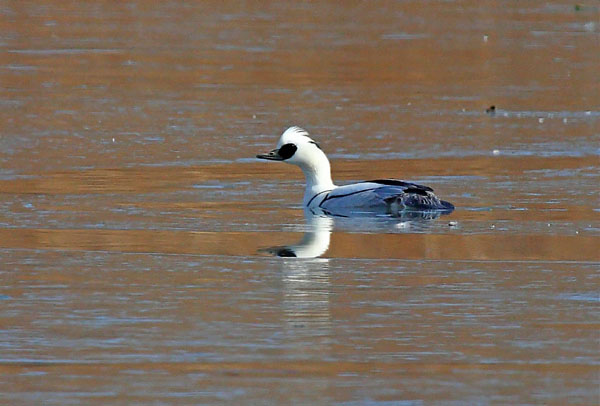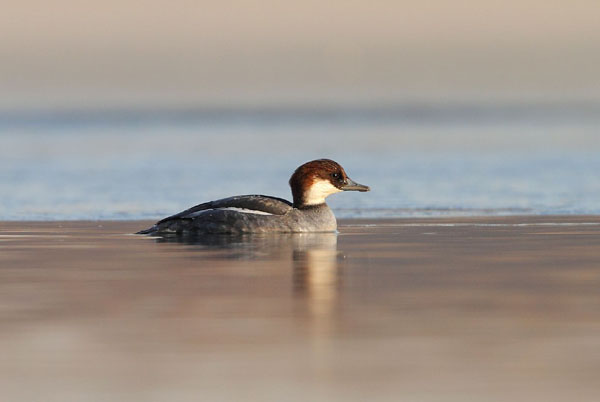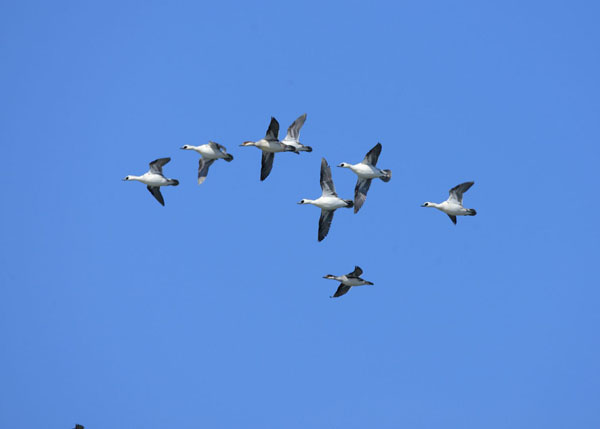Mergellus albellus
IUCN
LCBasic Information
Scientific classification
- name:Mergellus albellus
- Scientific Name:Mergellus albellus,Panda duck, flower-headed saw-billed duck, fish duck, dog-headed merganser, lesser merganser, spotted merganser
- Outline:Waterfowl
- Family:Anseriformes Anatidae M.genus
Vital signs
- length:340-456mm
- Weight:340-720g
- lifetime:6-9years
Feature
It is the smallest and shortest-beaked merganser.
Distribution and Habitat
In China, it breeds in the northeast and winters in the Songhua River, Yalu River, Yellow River, Yangtze River and Pearl River basins. It strays to Taiwan Island. Abroad, it is distributed in the northern Palearctic and winters in the southern Palearctic.
During the breeding season, the white-necked duck mainly inhabits lakes, rivers, ponds and other waters in forests or near forests, but prefers lowland riverside forests. In the non-breeding season, it likes to inhabit lakes, rivers, ponds, reservoirs, estuaries, bays and coastal brown marshes.
Appearance
Small in size, the male has black eye patch, occipital, upper back, chest and primary flight feathers, the rest of the body feathers are white, and there are gray worm-like stripes on both sides. The female has reddish brown head, upper cheek and back neck, white lower cheek, chin, throat to front neck, the rest of the body feathers are gray, and the lower abdomen is white. The iris is brown, the beak is short and slightly hooked, gray-black, and the feet are gray-black.
Details
The white merganser, also known as the spotted-headed merganser or panda duck, is a water duck of the Anatidae family and the genus Aglajidae. The male bird has mainly black and white feathers, while the female bird has dark brown upper body and white lower body. It breeds in tree holes or swamp waters, and forms small groups to hibernate in open waters. It dives for food, but its diving distance and time are shorter than those of other mergansers. It is the smallest merganser with the shortest beak.

The white merganser forages by diving. It is diurnal, and it forages in rivers and lakes during the day, and rests in reeds or tree holes at night. It forages during the day. They often swim on the calm lake surface and dive frequently to find food. The diving depth and duration of each dive are not as good as other mergansers, and usually the diving time is more than 15-20 seconds. The spotted merganser is an omnivorous bird. Its food includes small fish, crustaceans, shellfish, aquatic insects, stone silkworms and other invertebrates. It occasionally eats a small amount of plant food such as water plants, seeds, leaves, etc.
Except for breeding, the white merganser often moves in groups. Usually there are 7-8 to more than 10 in a group, and sometimes there are large groups of dozens of them. Especially during the migration season and winter. Usually males and females gather separately, and females and young birds often live further south. Generally like to move on calm lakes. Good at swimming and diving, they are active on the lake surface almost all day. Usually they swim and dive frequently to find food. When resting, they often wander back and forth in the waters near the lake or river, or live on stones and objects immersed in the water, and rarely go ashore. When swimming, the neck is stretched very straight, and sometimes the head is immersed in the water and dives frequently. When resting, it often wanders along the shore or perches on the beach by the water. It flies fast and straight, flapping its wings quickly, and often makes clear wing-beating sounds. It is very clumsy when taking off, and needs to flap its wings rapidly on the water surface and run on the water surface for a while before it can fly. It can also walk on the ground and often appears in urban parks and lakes.

In spring, a large number of white mergansers migrate northward from their wintering grounds in the south from mid-March to early April, and a small number migrate as late as early to mid-April. In autumn, they start to migrate from their breeding grounds in early to mid-September. They arrive at their wintering grounds in southern Northeast China, North China and south of it in October and November. They often migrate in small groups of 20-30. There are also small groups of a few to more than 10, and rarely move alone.
They mate and breed from February to May every year, and the marriage is polygamous. The chicks live with their mother for 3-4 months before migrating south with the group. They reach sexual maturity at 1-2 years old, and have a maximum lifespan of 9 years. The breeding season is from May to July. They nest in natural tree holes on old trees by the river or lake in the forest. They usually nest in tree holes at the top of trees such as pine and oak trees, and sometimes use black woodpecker holes. In the early stage of incubation, the male bird waits near the nest, and then leaves the female bird to molt alone. The incubation period is 28 days. The female bird is very attached to the nest.

The white-headed merganser has a beautiful appearance and a carefree swimming posture. It is a famous ornamental bird. The only drawback is that artificial breeding is extremely difficult, but the survival rate of chicks is very high, and it is easy to raise. The meat tastes fishy and the economic value is not high. Although the increasing destruction of the wetland environment has threatened the survival of this species, a survey in 2002 showed that there are about 130,000 to 210,000 mergansers in the world, and there is no danger of extinction. Winter was once more common in China, especially in the north of the Yangtze River, but the population has decreased significantly and has become quite rare and uncommon, and protection work needs to be strengthened.
Listed in the second level of the "List of National Key Protected Wildlife in China".








